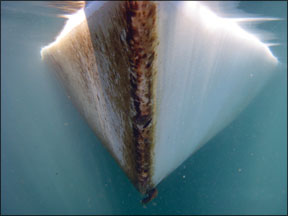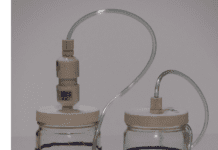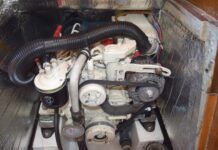
Photo courtesy of Unified Port of San Diego
288
As much as I enjoy messing around with boats, the job of prepping a hull and applying antifouling paint is one I could live without. A do-it-yourself paint job is not as loathsome as it used to be, but it’s still one of my least favorite tasks.
In recent years, paint makers have begun adding a range of water-based antifouling paints to their lineups. These new paints eliminate most or all of the strong solvents that make painting unpleasant and that, over time, can be harmful to our health and the environment. The difference between these almost odorless water-based paints and fume-laden solvent-based types is striking. As an added bonus, cleanup—a hose and a bucket—is a breeze.
While I’d like to believe the well-being of DIY boat owners was the force behind the new formulas, the real incentives were new Clean Air Act rules aimed at reducing the emission of volatile organic compounds (VOCs). VOCs easily vaporize in the atmosphere and have been blamed for a range of health and environmental problems. Architectural coatings—bottom paints among them—are regarded as a major source of these compounds. Boatbuilders and paint makers, particularly those in states like California with strict environmental regulations, are tasked with meeting much tighter emission standards for VOCs.
The move toward low or no-VOC paints was on my mind this month as I reviewed the results of a three-year study carried out by the Unified Port of San Diego. Funded by the U.S. Environmental Protection Agency, the study examined the effectiveness of paints with low or no biocides—the ingredients that prevent fouling because of their toxicity. More than 150 years after it was first combined with a hull paint, copper is still the principal biocide used today.
After reading the 152-page report, I got the impression that the scientists, boat owners, boatyards, and manufacturers involved in the study made a sincere effort to collect useful data in a test that can be fraught with variables—as PS well knows. (See the latest results of our bottom paint panel tests on page 8.)
According to the San Diego study, a biocide-free bottom paint that is cleaned every three weeks can match the performance and—over the long haul—the expense of using copper paint. While this kind of scrubbing routine may be fine in Southern California, it’ll be a tough sell in the Northeast, or for ocean voyagers.
I’m not too bothered by the test’s optimistic scenarios—like a 10-year life for a biocide-free paint—or limited field study. I am concerned about how this data might be used. The intent of the study is clear: Find a paint that is easy to clean, affordable, and contains no biocide. Though the cause is admirable, I’m not convinced there is one-size-fits-all solution to reducing biocides in bottom paints.
Fortunately, the study comes to a similar conclusion, even suggesting that biocide-free paints are not a good option for voyaging cruisers, since these biocides are more effective at keeping invasive species from hitching-hiking on boats and spreading to new areas. Hopefully, any new rules that might result from the study will recognize what paintmakers have known all along: There are different (paint)strokes for different boats.




































